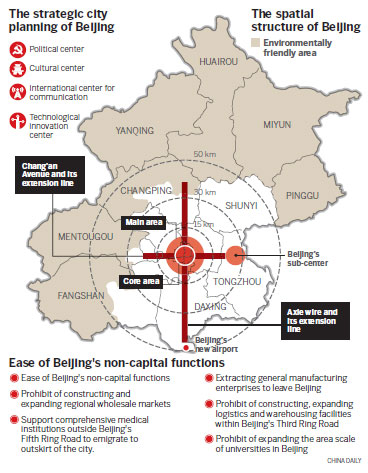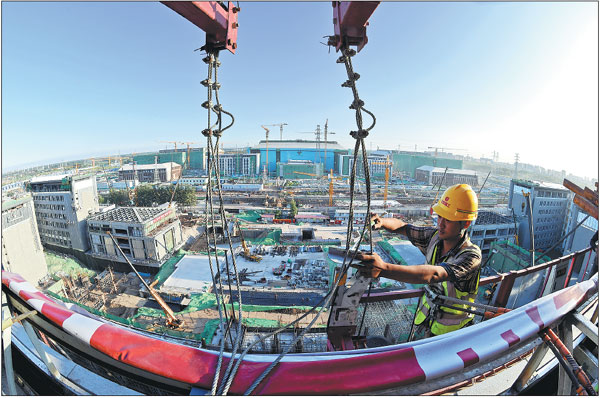Beijing's future mapped out for two decades
Key development blueprint answers questions on what kind of capital the metropolis will become
A blueprint for the development of China's capital over the next two decades, which caps the city's population at 23 million and calls for more green space, has been given the seal of approval by the central leadership.
The development plan of Beijing (2016-35), which was approved by the Central Committee of the Communist Party of China and the State Council on Sept 29, answers questions about what kind of city the capital will be over the next 20 years.
The development plan emphasizes Beijing's role as the capital city and an international metropolis.
It envisages the strengthening of its functions as a center for politics, culture, and international communications, as well as scientific and technological innovation in its core areas, said Cai Qi, Party chief of Beijing.

Its role as a political center requires the maintenance of good security, to ensure the national government operates smoothly.
To achieve those goals, the height of buildings will be restricted to a certain level and security risks will be closely controlled.

The cultural center focuses on the preservation of Beijing's local culture, as well as the heritage of the ancient part of the city.
"The city's protection should be a top priority, involving the rejuvenation of the ancient town, which is Beijing's central axis, the imperial palaces established during Ming and Qing dynasties, as well as the historical rivers and lake systems," said Cai.
The government will also support the development of public cultural services and innovation-driven cultural industries.
Plans for the international communications center emphasizes construction of both hardware and software facilities.
It means the government will not only build more convention centers, but also deepen international access to the capital.
The construction of the center for scientific and technological innovation will employ a strategy that supports major projects at the vanguard of the development of technological innovation.
Beijing's Zhongguancun Science Park, Huairou Science Park, Future Science City, as well as the Made in China 2025 strategy demonstration zones are on the list.
The key to Beijing's functioning as a capital is to protect its historical heritage.
"It is also the major window to showcasing the charms of Beijing," Cai said. "To better implement the plan for the smooth development of Beijing's non-capital functions, we should continue to reduce the pressures of population and the density of buildings, as well as the pressures on the commercial and tourism areas," Cai said.
To address the issue of population pressure, the development plan announced it will target keeping Beijing's population to 23 million by 2020, with 10.85 million in the city's six core districts.
"The population target was the result of scientific calculations that considered Beijing's water resources, land resources, energy supply as well as its ecology," said Zhang Wei, deputy secretary-general of Beijing Municipal Government.
"It is a practical goal to adjust Beijing's population to sustainable development."

While controling its population, Beijing will increase its housing supply and improve the current rental housing system. The government will grant more rights to renters and provide more public housing to non-local people.
The next five years will see the supply of all types of new housing top 1.5 million units in Beijing, including more houses for rent.
"Adhering to strict restrictions on property purchases for the Beijing housing market, the city will strengthen measures to curb speculative investment in housing to prevent financial risks," Zhang said.
Meanwhile, Cai said ecological conservation was another major part of the development plan. The development plan establishes goals for the development of the city's ecology. It sets a target that by 2020 the ecological area - including mountains, forests, rivers and lakes, conservation areas, nature reserves and scenic spots - will take up 73 percent of the city's total area, increasing to 75 percent by 2035.
"This new version of the development plan conforms to the reality and development goals of Beijing," Cai said.
Wang Menghui, head of China's Ministry of Housing and Urban-Rural Development, said that Beijing was home to the people working and living in the city. He added that it was everyone's responsibility to ensure Beijing continued to evolve as an excellent capital.
The coordinated development of Beijing, Tianjin and Hebei province was stressed in the development plan, along with the 2022 Winter Olympics to be held in Beijing and Hebei's Zhangjiakou.
It said the event's main competition venues and infrastructure should all be finished by the end of 2019.
The blueprint also outlined more railways and highways, saying more major traffic routes connecting Beijing, Tianjin and Hebei were in the pipeline.
liyou@chinadaily.com.cn
|
A worker constructs building frames at a construction site of Beijing’s sub-center. Luo Xiaogang / Xinhua |
(China Daily 10/18/2017 page14)















